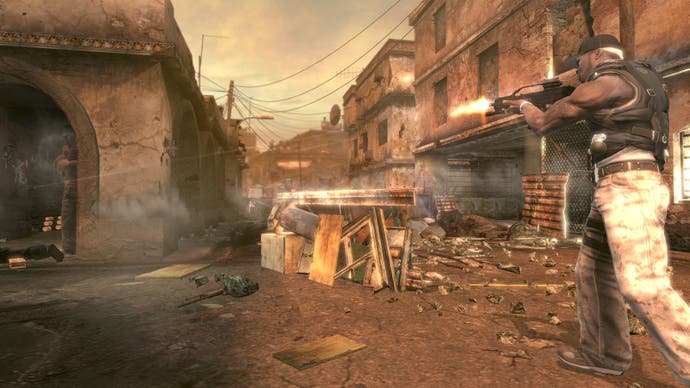50 Cent: Blood on the Sand
Off the hook, the map, the meat rack and radar.
Counter-kills are quick-time events, where pressing B during close combat initiates a move that's about as subtle as a flare gun to the testes. 50 steps to his enemy and stabs them in the face a couple of times, and then sticks one in the belly for good measure. It's graphic even by videogame standards. Once earnt, the 21 different counter-kills (which include stabbing a foe in the arse, tastefully - you've got to wonder about the designer who came up with that) can be assigned to a 'playlist', so you can have a number of your favourites on hand. Oddly, the player doesn't choose which move to perform, it's decided automatically.
Players do get to choose a partner before each level - Tony Yayo, Lloyd Banks or DJ Whoo Kid - all of which think for themselves and act as wingmen. "We had a lot of conversations about the collaborative character, about whether we made it complicated where you could give orders, set tactical strategies, but we decided for a game that's so openly arcadey it didn't make any sense," details Widdows. "The player wouldn't really want to get engaged in that sort of thing."
What Swordfish is doing is having the non-player character work forwards of Fiddy's position, to give the illusion that you're both involved in the firefight and sharing the drama (rather than a AI buddy who lollops around in the background), and also to lead the player through the level design. The buddy doesn't play differently depending on which character you choose either; it's just a different skin and voice-over according to Widdows: "We didn't want the player to have to restart thinking they made the wrong decision". The better news is that, when they go online, players can jump straight in as the second character to make it a true co-op experience.

And finally, the third elephant in the room. The one wearing a balaclava and holding an AK-47: the locations, the environment with its arched doors and Arabic-looking script. The enemies in head-scarves. The Blood on the Sand moniker. Is this 50 Cent taking on the Taliban? Is this Fiddy Fights Iraq?
"Blood in the Sand does suggest it's somewhere sandy," says Widdows. "That's the subtitle chosen by the marketing teams in the US and Violator (the management and record label responsible for 50 and G-Unit). But the bad guy you fight is an American. Most of its henchmen are Russian."
"It's a pastiche of warzones. There are definitely Eastern influences in parts of the game but the art team wanted to create something that could have been anywhere from the Baltic states to a Persian influence. I think it's pretty much impossible to put it in one place," adds Widdows. For the record, we asked a spokesperson from publisher Sierra if the company would address this issue further, but it declined. It might want to be a bit careful with the way it's marketed - kids look up to 50, and those locations might be seen as insensitive - but then it's not like his musical and movie output is any more subtle.

Like Bulletproof, Blood on the Sand isn't a game about hiphop or rap music, it's a bat-shit shooter where the main character happens to be an international rap star. There's an element of the macho, pecker-waving gunplay that puts it in the same bracket as Army of Two and Gears of War, but those games also delivered very solid shooter mechanics and more than a few hours of entertainment. If Blood on the Sand delivers the tight, arcade shooter its makers are hoping for, that should hopefully shine past 50 Cent's ego, his iced-out character, and the marketing dollars that surround a rap icon.
50 Cent: Blood on the Sand is due out on PS3 and 360 in the autumn.

